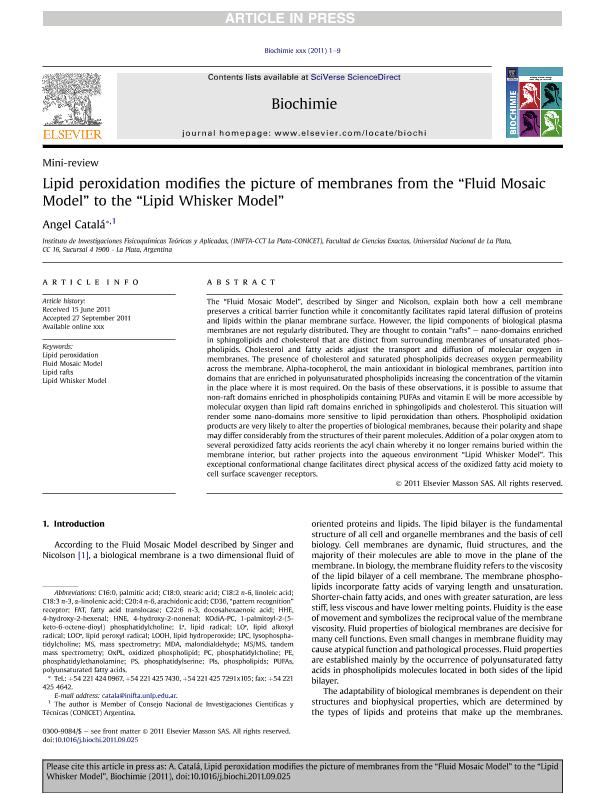Mostrar el registro sencillo del ítem
dc.contributor.author
Catala, Angel

dc.date.available
2016-04-15T16:12:39Z
dc.date.issued
2012-01
dc.identifier.citation
Catala, Angel; Lipid peroxidation modifies the picture of membranes from the “Fluid Mosaic Model” to the “Lipid Whisker Model”; Elsevier Masson; Biochimie; 94; 1; 1-2012; 101-109
dc.identifier.issn
0300-9084
dc.identifier.uri
http://hdl.handle.net/11336/5229
dc.description.abstract
The “Fluid Mosaic Model”, described by Singer and Nicolson, explain both how a cell membrane preserves a critical barrier function while it concomitantly facilitates rapid lateral diffusion of proteins and lipids within the planar membrane surface. However, the lipid components of biological plasma membranes are not regularly distributed. They are thought to contain “rafts” e nano-domains enriched in sphingolipids and cholesterol that are distinct from surrounding membranes of unsaturated phospholipids. Cholesterol and fatty acids adjust the transport and diffusion of molecular oxygen in membranes. The presence of cholesterol and saturated phospholipids decreases oxygen permeability across the membrane. Alpha-tocopherol, the main antioxidant in biological membranes, partition into domains that are enriched in polyunsaturated phospholipids increasing the concentration of the vitamin in the place where it is most required. On the basis of these observations, it is possible to assume that non-raft domains enriched in phospholipids containing PUFAs and vitamin E will be more accessible by molecular oxygen than lipid raft domains enriched in sphingolipids and cholesterol. This situation will render some nano-domains more sensitive to lipid peroxidation than others. Phospholipid oxidation products are very likely to alter the properties of biological membranes, because their polarity and shape may differ considerably from the structures of their parent molecules. Addition of a polar oxygen atom to several peroxidized fatty acids reorients the acyl chain whereby it no longer remains buried within the membrane interior, but rather projects into the aqueous environment “Lipid Whisker Model”. This exceptional conformational change facilitates direct physical access of the oxidized fatty acid moiety to cell surface scavenger receptors.
dc.format
application/pdf
dc.language.iso
eng
dc.publisher
Elsevier Masson

dc.rights
info:eu-repo/semantics/openAccess
dc.rights.uri
https://creativecommons.org/licenses/by-nc-nd/2.5/ar/
dc.subject
Lipid Peroxidation
dc.subject
Fluid Mosaic Model
dc.subject
Lipid Rafts
dc.subject
Lipid Whisker Model
dc.subject.classification
Bioquímica y Biología Molecular

dc.subject.classification
Ciencias Biológicas

dc.subject.classification
CIENCIAS NATURALES Y EXACTAS

dc.title
Lipid peroxidation modifies the picture of membranes from the “Fluid Mosaic Model” to the “Lipid Whisker Model”
dc.type
info:eu-repo/semantics/article
dc.type
info:ar-repo/semantics/artículo
dc.type
info:eu-repo/semantics/publishedVersion
dc.date.updated
2016-05-06 15:52:43.262787-03
dc.journal.volume
94
dc.journal.number
1
dc.journal.pagination
101-109
dc.journal.pais
Francia

dc.journal.ciudad
Paris
dc.description.fil
Fil: Catala, Angel. Consejo Nacional de Investigaciones Científicas y Técnicas. Centro Científico Tecnológico la Plata. Instituto de Investigaciones Fisicoquímicas Teóricas y Aplicadas; Argentina. Universidad Nacional de La Plata; Argentina
dc.journal.title
Biochimie

dc.relation.alternativeid
info:eu-repo/semantics/altIdentifier/pmid/21983178
dc.relation.alternativeid
info:eu-repo/semantics/altIdentifier/doi/http://dx.doi.org/10.1016/j.biochi.2011.09.025
dc.relation.alternativeid
info:eu-repo/semantics/altIdentifier/doi/10.1016/j.biochi.2011.09.025
dc.relation.alternativeid
info:eu-repo/semantics/altIdentifier/url/http://www.sciencedirect.com/science/article/pii/S0300908411003762
Archivos asociados
